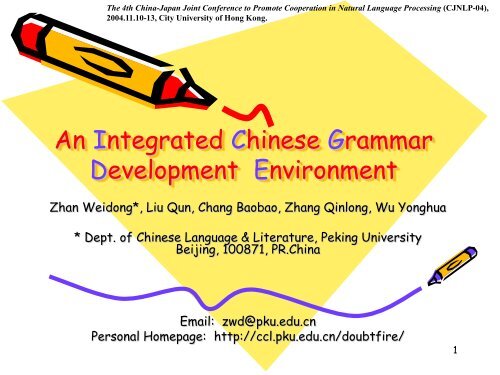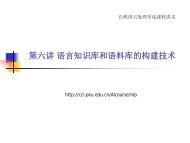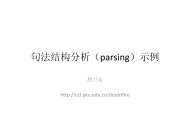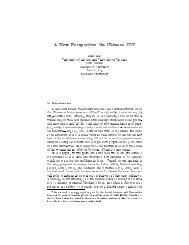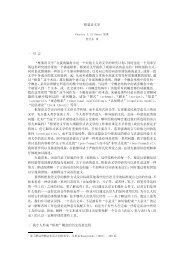Linguistic Knowledge Base
Linguistic Knowledge Base
Linguistic Knowledge Base
You also want an ePaper? Increase the reach of your titles
YUMPU automatically turns print PDFs into web optimized ePapers that Google loves.
The 4th China-Japan Joint Conference to Promote Cooperation in Natural Language Processing (CJNLP-04),<br />
2004.11.10-13, City University of Hong Kong.<br />
An Integrated Chinese Grammar<br />
Development Environment<br />
Zhan Weidong*, Liu Qun, Chang Baobao, Zhang Qinlong, Wu Yonghua<br />
* Dept. of Chinese Language & Literature, Peking University<br />
Beijing, 100871, PR.China<br />
Email: zwd@pku.edu.cn<br />
Personal Homepage: http://ccl.pku.edu.cn/doubtfire/<br />
1
Outline of Talk<br />
1) Introduction: Why we need ICGDE?<br />
2) What does ICGDE consist of?<br />
3) What is the characteristics of ICGDE?<br />
4) What have been done with ICGDE<br />
5) Future works<br />
2
1 Introduction<br />
• There are many applications which require a sentence parser as a<br />
core or fundamental component. For instance, MT, Humancomputer<br />
interface, IE, IR, etc..<br />
• Whatever the applications make use of shallow parsing techniques<br />
or rely on deep analysis, precise large-coverage grammars,<br />
lexicons and annotated corpus of natural languages are always<br />
needed to build up.<br />
• Developing such so-called linguistic knowledge base(LKB, for short)<br />
is a very time-consuming and difficult activity. The following<br />
factors are often needed to taken into consideration: coverage,<br />
granularity, efficiency, etc..<br />
• We need a LKB development environment that can process various<br />
forms of linguistic knowledge effectively and integrate them into<br />
an organized system to support applications of NLP and linguistic<br />
research and teaching.
Overseas Researches on<br />
Development of <strong>Linguistic</strong> Resource<br />
• INTEX: A <strong>Linguistic</strong> Development Environment<br />
(http://www.nyu.edu/pages/linguistics/intex/)<br />
• The LinGO (<strong>Linguistic</strong> Grammars Online) project<br />
(http://lingo.stanford.edu)<br />
• Language Resources & Evaluation Conference<br />
(http://www.lrec-conf.org/)<br />
• Xerox <strong>Linguistic</strong>s Environment Project<br />
(http://www2.parc.com/istl/groups/nltt/xle/)<br />
• XTAG System<br />
(http://www.cis.upenn.edu/~xtag/release-8.31.98-html/node12.html)<br />
4
Our Ongoing Projects<br />
Our research work is now supported by several state-funded<br />
projects which are listed below.<br />
• 2002.1 -- 2006.12 Construction Rules of Chinese Sentence And<br />
Development Environment of Chinese Parsing System, funded by<br />
Ministry of Education of China (Project No.200110)<br />
• 2002.1 -- 2004.12 Study on Annotation Specification of Chinese<br />
Phrases and Sentence Patterns, funded by Ministry of Education<br />
of China (Project No.YB105-49)<br />
• 2002.12 -- 2005.12 Computing Platform for Research on<br />
Contemporary Chinese and Information Processing, funded by “211<br />
Project” of The National Tenth Five-year Plan<br />
5
Research Collaboration<br />
Computing-oriented research on natural language needs interdisciplinary<br />
collaboration more than traditional language research works.<br />
Our research team is composed of linguists and computational linguists<br />
from four institutes, including:<br />
• Department of Chinese Language and Literature, Peking University<br />
• Center for Chinese <strong>Linguistic</strong>s, Peking University<br />
• Institute of Computing Technology, Chinese Academy of Sciences<br />
• Institute of Computational <strong>Linguistic</strong>s, Peking University<br />
6
2 What does ICGDE consists of<br />
1<br />
2<br />
3<br />
4<br />
Parser<br />
Management Tools<br />
Debugging tools<br />
Evaluation tools<br />
Rule set<br />
Lexicon<br />
Corpus<br />
Treebank<br />
5<br />
6<br />
7<br />
8<br />
<strong>Linguistic</strong><br />
<strong>Knowledge</strong><br />
<strong>Base</strong><br />
1,2,3,5 will be discussed detailedly in the following sections.<br />
4 is under construction. 6,7,8 are shown in appendix.<br />
7
Unparsed<br />
sentence<br />
Workflow of ICGDE<br />
Debugging tools<br />
GCG Parser<br />
L K B<br />
L K B<br />
new version<br />
Tracing data<br />
parsed<br />
sentence<br />
Management Tools<br />
for LKB<br />
Evaluation Tools<br />
8
The main interface of GCG parser
3 What is the characteristics of ICGDE?<br />
In this section, we are going to talk about the highlighted<br />
features of the three main modules in ICGDE<br />
1) A Chinese Parser with fully constraint-based<br />
grammar formalism (GCG parser)<br />
2) Tools for linguistic rule writing and debugging<br />
3) Tools for building and using Chinese Treebank<br />
10
About the<br />
parser①<br />
3.1 A Chinese Parser with fully<br />
constraint-based grammar formalism<br />
About the<br />
linguistic<br />
knowledge<br />
representation<br />
• Non-deterministic Bottom-up Chart parser<br />
• Towards a multi-engine approach<br />
• Configurability and Customization<br />
• CFG rule enhanced with marking the head of a phrase(like<br />
HPSG formalism) and the right hand side of a production<br />
rule is allowed to be composed of non-terminal symbols and<br />
trees(like Tree Adjoining Grammar formalism)<br />
• Each rule is decorated with feature structure-based<br />
unification<br />
• Built-in Functions and operators for enhancing the capability<br />
of construction rules<br />
• Score mechanism for disambiguation of competing rules<br />
footnote:① The main architecture and the core module<br />
of the parser is designed and developed by Dr. Liu Qun<br />
11
Multi-engine architecture of the parser<br />
• The parser consists of various micro-engines which share a same<br />
chart data structure while parsing. Each engine uses its own<br />
linguistic resource to make contribution to add new nodes with<br />
score into the chart. It is allowed to use different engine to do<br />
the same job. For example, we can use different Chinese word<br />
segmenter and POS-tagger in our parser. The nodes which are<br />
derived from different engines and cover the same segment of<br />
input string will be selected according to their score.<br />
• Each micro-engine is bound to its own linguistic knowledge base,<br />
which can be various form and on the different linguistic level,<br />
such as lexicon, rule set, corpus, probability parameters, etc..<br />
12
Multi-engine architecture of the parser<br />
A pipelined multi-engine approach to Chinese parsing<br />
13
Configurability and Customization<br />
To set<br />
weight for<br />
adjusting<br />
score of a<br />
parsed node<br />
depending on<br />
different<br />
conditions<br />
micro<br />
engines are<br />
listed here<br />
that can be<br />
switched on<br />
and off<br />
To specify a<br />
coefficient to<br />
calculate the<br />
maximum<br />
amount of tree<br />
nodes for<br />
parsing one<br />
sentence<br />
To specify<br />
the<br />
maximum<br />
amount of<br />
time for<br />
parsing one<br />
sentence<br />
14
Configurability and Customization(cont.)<br />
segmentation and pos tagging<br />
parsing a sentence with word<br />
segmentation and pos tag<br />
parsing a sentence unannotated<br />
User can choose an<br />
output format from<br />
different styles<br />
15
Configurability and Customization (cont.)<br />
• Each micro-engine can be switched on and off before parsing a<br />
sentence<br />
• User can put a new engine into the parser if necessary, for example,<br />
name entity recorgnizer and shallow parsing engine may be needed to<br />
add for information extraction system.<br />
• User can set up the time limitation for parsing a sentence<br />
• User can set up the maximum amount of tree nodes created by parsing<br />
one sentence as a limitation<br />
• User can set weight for adjusting score of a parsed node in the<br />
different cases. For example, if a node contains punctuation, its score<br />
should be reduced slightly<br />
• User can choose different input and output format<br />
16
Enhanced CFG production rule<br />
Global rule<br />
pp->!p np<br />
ap->!ap c ap<br />
np->mp !np<br />
...<br />
-- different coverage--<br />
A non terminal symbol in the<br />
left hand side of a rule<br />
(root node of a tree) can be<br />
rewrite as more than two<br />
symbols(branches) in the<br />
right hand side<br />
Local rule<br />
pp -> !p tp v<br />
tp -> mcp !q mcp q<br />
vp -> pp( !p np ) !vp(!vp vp(!vp np))<br />
so called “mildly context sensitive grammar<br />
formalism” like TAG-style grammar<br />
the right hand side of a rule can contain<br />
one or more trees instead of just nodes<br />
ap -> m q p m q !ap<br />
...<br />
If one or more nodes in the right hand side are<br />
specified with terminal symbol,i.e. word, this kind<br />
of rule is called “local rule” for its locality.<br />
carried the books to library<br />
17
CFG production rule with constraints<br />
&& {npdz11} np->vp !n :: $.内部结构=粘合定中,$.定语=%vp,$.中心语=%n,<br />
Rule-ID<br />
start symbol of a rule<br />
a sequence of<br />
constraints that<br />
are separated by<br />
comma<br />
delimiter<br />
stands for root node<br />
cfg rewriting rule<br />
%vp.后名=是,%n.前动=是,%vp.内部结构=单词|联合,<br />
IF %vp.内部结构=单词 THEN %vp.兼类=~n ENDIF,<br />
IF %vp.内部结构=单词,%vp.音节=2, %n.音节=2 THEN<br />
#Score(5) ENDIF,<br />
IF %vp.内部结构=单词,%vp.音节=1, %n.音节=2 THEN<br />
#Score(-5) ENDIF,<br />
IF #GetLength(%vp) > 4 FALSE<br />
stands for the first node<br />
appears in the right hand<br />
side of the rule<br />
# symbol is always followed by a built-in function<br />
Basically, each constraint is independent from each other.<br />
But it will be easier to read if the constraints can be<br />
written in good order.<br />
18
CFG production rule with constraints(cont.)<br />
There are four types of constraints listed here one after another.<br />
1) The first type of constraint is used to initialize the value of some<br />
required features of a rule. For example, the equation “$.内部结构=粘合定中”<br />
means that the internal relation of this construction is Modifier-Head.<br />
2) The second type of constraint is used to describe that the constitutes<br />
of a phrase should satisfy certain conditions. For example, the equation<br />
“%vp.后名=是” means that the property “后名” of the first vp in the<br />
phrase should has a value “yes”. If the value of a verb is “no”, the condition<br />
is unmatched and then the verb is rejected by this rule<br />
19
CFG production rule with constraints(cont.)<br />
3) The third type of constraint is also used to describe the<br />
constraints like the second one. But the form is different. Like<br />
programming language designed for computer, we can use the sentence<br />
of “IF ... FALSE”, “If ... Then ... Endif”, “IF ... then ... else ... Endif”,<br />
etc., to describe compound conditions.<br />
4) The fourth type of constraint contains built-in functions and<br />
operators that can be used to enhance the capability of writing<br />
constraints for rules. The usage of built-in functions will be<br />
illustrated in the next slides.<br />
20
Built-in Functions and Operators<br />
All built-in functions can be classified into the following four<br />
types according to the type of value returned by a function.<br />
Bool Function<br />
MatchPattern<br />
Score<br />
Int Function<br />
NumOfChild<br />
GetLength<br />
FindWord<br />
String Function<br />
SubString<br />
Node Function<br />
GetMostRightNode<br />
GetMostLeftNode<br />
GetLeafNode<br />
Operator: > < >=
Usage Illustration of Built-in Functions<br />
ex.1 GetLength()<br />
The top right parsing tree is not correct.<br />
In order to avoid it, we can make use of the<br />
function GetLength() in the following rule:<br />
{vp1} vp -> !vp u :: ..., IF #GetLength(%vp) >=4 FALSE, ...<br />
The verb phrase(vp) “把 + 书 + 运 + 到 ”<br />
consists of four words. So the function<br />
GetLength took this vp as argument will<br />
return the integer value 4, which<br />
satisfy the unification condition<br />
“#GetLength(%vp) >=4 ”. The rule vp1,<br />
therefore, is rejected while parsing the<br />
phrase. And then the expected result is<br />
produced. See the bottom right parsing<br />
tree.<br />
carried the books to library<br />
22
Usage Illustration of Built-in Functions<br />
ex.2 GetLeafNode()<br />
The function GetLeafNode takes two<br />
arguments. The first argument is a tree node,<br />
the second argument is the index of a leaf<br />
node which is projected by the tree node that<br />
the first argument denotes. For instance, in<br />
order to eliminate the incorrect parsing<br />
tree(shown top right), we can make use of this<br />
function in writing the following rule:<br />
{vp2} vp -> np !vp :: ..., IF %GetLeafNode(%np,-1).原形=的 FALSE, ...<br />
The second argument “-1” is interpreted<br />
as the most right leaf node of the first<br />
argument, i.e. np. The above constraint<br />
means that a np ended with “的” can<br />
NOT be positioned before a vp as its<br />
adverbial modifier. In the above rule,<br />
GetLeafNode returns the leaf node “的”,<br />
whose feature “原形”(lexmeme) has the<br />
value “的”. So the unification will succeed.<br />
most people DE support<br />
support by most people<br />
23
Score mechanism<br />
• Using a simple score mechanism to make fine granularity<br />
set different score thresholds for individual rules or<br />
different lexicons depending on their credibility<br />
for instance:<br />
1) basic lexicon vs. extended lexicon<br />
2) global rule vs. local rule<br />
3) two global rules with same construction but different frequency<br />
24
Local rule<br />
Score mechanism (cont.)<br />
Global rule<br />
&& {vpdao1} vp -> pp( !p np ) !vp(!vp vp(!vp np)) && {vpzz1} vp->pp !vp<br />
A node generated by local rule is assumed to have higher score than the<br />
node with same label that is generated by global rule. In the case of<br />
above example, the left tree will be ranked higher than the right one and<br />
be selected as the final result to output.<br />
a hybrid formalism for representation of linguistic rule<br />
25
3.2 Tools for linguistic rule writing<br />
and debugging<br />
• Management tools for linguistic <strong>Knowledge</strong> base<br />
• Tracing the parsing process<br />
26
Management Tools for <strong>Linguistic</strong><br />
<strong>Knowledge</strong> <strong>Base</strong><br />
• Grammar checking for linguistic knowledge base<br />
• The interface for linguistic knowledge base<br />
edit, add, delete, search, etc..<br />
• Compiling linguistic source files to object files<br />
which are used in parsing indeed.<br />
27
Cascading<br />
style<br />
menu<br />
Handy<br />
editing<br />
of a rule<br />
searched<br />
by it’s<br />
title<br />
Management Interface of LKB<br />
compiling linguistic source file<br />
into internal data for parsing,<br />
exporting txt format file<br />
from internal data<br />
Once this button is pressed, the current<br />
edited rule will be compiled and added into<br />
the internal data structure for parsing. It’s<br />
not necessary to compile whole linguistic<br />
knowledge base after an individual rule or<br />
lexical entry is modified. This is so-called<br />
partial compiling.
Tracing<br />
There is a button to trace the<br />
execution of the parser. It<br />
can be switched on and off<br />
before start of parsing.<br />
Tracing can give more insight<br />
on what the parsing behaves.<br />
All detailed tracing<br />
information is saved in a text<br />
file which contains the<br />
following descriptions.<br />
•The micro-engines are called<br />
in parsing<br />
•The feature structure and<br />
the score of each node<br />
•The rules are employed in<br />
parsing<br />
•The parsed trees We have planned to add the function of setting breakpoint for<br />
enforcing the debugger. But it’s not available now.
3.3 Tools for building and using Chinese Treebank<br />
• Tree Editor<br />
• Rule Extraction<br />
• Search in Treebank<br />
• Subtree replacement<br />
30
Tree Editor<br />
tree editing<br />
area, in which<br />
user can edit<br />
manually the<br />
label of a tree<br />
node, add a<br />
new child node<br />
to a selected<br />
tree node,<br />
combine two<br />
leaf nodes,<br />
drag a selected<br />
tree node to<br />
be the child<br />
node of<br />
another target<br />
tree node, and<br />
so on.<br />
tree viewing area, in which a parsed tree is<br />
shown as user-friendly graphic inverted tree.<br />
a list of trees inputted from<br />
the output of the GCG parser
Rule extraction from a treebank<br />
It can<br />
increase the<br />
coverage of<br />
rule set<br />
effectively to<br />
extract rules<br />
from a<br />
manually<br />
corrected<br />
treebank.<br />
The rules extracted can be sorted by different criteria, such as<br />
the label of root node, the right hand side symbols of a rule,<br />
frequency of rule, number of child nodes of a root node<br />
32
The tree you want<br />
to search<br />
Note:The white square<br />
can match any<br />
tree node<br />
Search in treebank<br />
specify the label of root<br />
node you want to search<br />
specify the child nodes of root<br />
node you want to search
Subtree replacement<br />
find the tree<br />
below that is<br />
embedded in<br />
larger trees<br />
You can type * as both root node and leaf node that matches<br />
any label for a tree node when you input a tree for searching<br />
and replacing.<br />
replace the<br />
found tree(s)<br />
with the tree<br />
below
4 Experiences with ICGDE<br />
• Statistics of current linguistic knowledge database<br />
• Precision and efficiency of the parser<br />
• Statistics of current PKU Chinese treebank<br />
35
4.1 Statistics of current linguistic<br />
knowledge database<br />
• Core lexicon: more than 43,000 entries with rich<br />
syntactic and semantic information in attribute-value<br />
format<br />
• Appended lexicon: more than 200,000 entries with just<br />
part-of-speech tag. Entries in this lexicon are almost<br />
compound word or multi-words unit.<br />
• Phrase database: more than 30,000 entries which are<br />
annotated with part-of-speech of words that constructs a<br />
phrase and the functional category and internal structure<br />
of the phrase<br />
• Rule set: more than 900 rules, including 330 global rules<br />
and 577 local rules<br />
36
4.2 Precision and efficiency of the parser<br />
• The test set contains 500 sentences, 5000 Chinese characters<br />
(4028 words).<br />
• The average sentence length is 10 characters per sentence (or 8<br />
words per sentence).<br />
• The computer used for testing is configured with 2.60GHz Pentium<br />
4 processor, 512MB SDRAM<br />
The above statistics is produced by Dr. Chang Baobao who used the bracket scoring<br />
program developed by Dr. Satoshi Sekine. The program is free for downloading online.
4.3 Statistics of current PKU Chinese treebank<br />
• There are 14,736 bracketed sentences that were corrected manually in<br />
the treebank.<br />
9.628 words on average each sentence<br />
• The treebank contains 12,685 word types and 141,879 word tokens now.<br />
• 2477 rules can be extracted from the treebank<br />
38
5 Future works<br />
The ICGDE and the linguistic knowledge base described above can<br />
continue to be actively developed.<br />
Our planned research is focused in the following areas:<br />
• improving ability of current debugging tool, including to set<br />
breakpoint, record more tracing data while parsing, etc..<br />
• extending the current rule set and lexicon through acquisition from<br />
corpora<br />
• enhancing functionality of current management tool for linguistic<br />
knowledge base, especially focusing on environment of collaborative<br />
grammar coding<br />
• developing evaluation technology for integration of existing<br />
linguistic resources<br />
39
Appendix: Resources Online<br />
• PKU Chinese Treebank Online<br />
http://ccl.pku.edu.cn/doubtfire/projects/chinesesentencestructure/<br />
• Online Chinese Semantic Lexicon<br />
http://ccl.pku.edu.cn/ccl_sem_dict/<br />
• Online Chinese Balanced Corpus with search engine support<br />
http://ccl.pku.edu.cn/ccl_corpus/jsearch/<br />
40
Online Chinese Semantic Lexicon (CCL, PKU)<br />
Entries can<br />
be<br />
accessed<br />
for<br />
browsing,<br />
editing,<br />
searching<br />
via<br />
Internet.<br />
Authorized<br />
users can<br />
add new<br />
entries and<br />
delete<br />
entries.<br />
hierarchical<br />
semantic<br />
tree for<br />
Chinese<br />
nouns
Online Concordance Service for Chinese Corpus<br />
• Both modern and<br />
classical Chinese are<br />
contained in the<br />
balanced corpus that<br />
exceeds 100 million<br />
Chinese characters<br />
now.<br />
• Support both single<br />
term query and complex<br />
multi-term query for<br />
searching which can<br />
meet most<br />
requirements for<br />
language studying.
Reference<br />
• Ann, Copestake & Flickinger Dan (2000), An Open Source Grammar Development<br />
Environment And Broad-coverage English Grammar Using HPSG, In Proceedings of LREC<br />
2000 (The 2nd International Conference on Language Resoruce & Evaluation), Zappeion<br />
Megaron, Greece, May 31 – June 2, 2000.<br />
• Blevins, James(2003), Feature-based Grammar, In Borsley, R.D. & Borjars, K. eds., Nontransformational<br />
Syntax, Oxford: Blackwell, to be published in 2005.<br />
• Blache, Philippe, Marie-Laure Guйnot, Tristan van Rullen (2003), A Corpus-based Technique<br />
for Grammar Development, In Proceedings of The Shallow Processing of Large Corpora<br />
Workshop (SProLaC 2003), Lancaster University (UK), 27 March, 2003.<br />
• Borsley, Robert D., 1996, Modern Phrase Structure Grammar, No. 11 in Blackwell<br />
textbooks in <strong>Linguistic</strong>s, Blackwell Publishers Inc..<br />
• Chen,Feng-yi, et al. 1999, Sinica Treebank, Computational <strong>Linguistic</strong>s and Chinese Language<br />
Processing,4(2):183-204<br />
• Chen, Keh-Jiann & Yu-Ming Hsieh, 2002, Chinese Treebanks and Grammar Extraction,<br />
CJNLP’2002, Peking University, 2002.10.30-11.2<br />
• Erbach, Gregor (1991), A Flexible Parser for a <strong>Linguistic</strong> Development Environment, In O.<br />
Herzog & C.-R. Rollinger eds., Text Understanding in LILOG, Springer, 1991, pp. 74-87<br />
44
Reference<br />
• Heinecke, Johannes, Jurgen Kunze, Wolfgang Menzel, and Ingo Schroder (1998),<br />
Eliminative parsing with graded constraints. In Proceedings of 17th International<br />
Conference on Computational <strong>Linguistic</strong>s, 36th Annual Meeting of the ACL, Coling-ACL '98,<br />
Montreal, Canada, 1998.<br />
• Knight,Kevin,1989, Unification: A Multidisciplinary Survey, ACM Computing Surverys,<br />
Vol.21, No.1.<br />
• Sag, Ivan A. & Thomas Wasow, 1999, Syntactic Theory: A Formal Introduction, CSLI<br />
Publications, Stanford, California.<br />
• Schmid, Helmut (1999), YAP: Parsing and Disambiguation With Feature-<strong>Base</strong>d Grammar.<br />
PhD thesis, Institute of Maschinelle Sprachverarbeitung, University Stuttgart, Germany,<br />
1999.<br />
• Suzuki, Hisami (2002), A Development Environment for Large-scale Multi-lingual Parsing<br />
Systems, In Workshop on Grammar Engineering and Evaluation (Post-conference<br />
workshop in conjunction with COLING-2002, Taipei, Sept. 1, 2002).<br />
• Uszkoreit, Hans(2002), New Chances for Deep <strong>Linguistic</strong> Processing, Coling2002,Taipei.<br />
• Volk, Martin & Dirk Richarz (1997), Experiences with the GTU Grammar Development<br />
Environment, ACL workshop on Environments for Grammar Development, 1997, Madrid,<br />
Spain.<br />
• Xu,Ruifeng, et al., 2004, The Construction of A Chinese Shallow Treebank, ACL2004<br />
SIGHAN Workshop, July 21-16, 2004. Barcelona, Spain.<br />
• 詹卫东(2000),《面向中文信息处理的现代汉语短语结构规则研究》,清华大学出版社,广<br />
西科学技术出版社。<br />
45
Thank you<br />
for your attention<br />
Welcome to<br />
http://ccl.pku.edu.cn<br />
46


